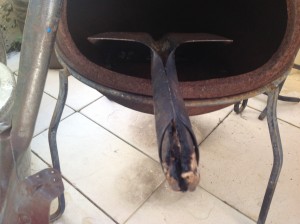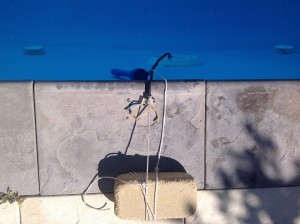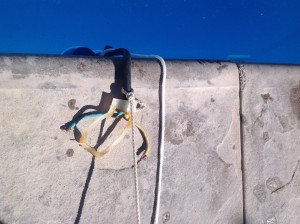A head-injured moment happens when you do something without enough quality control and it comes out less than perfect. Maybe you did it too quickly to get it just right. Maybe you would’ve done it better if you’d waited until the time was right, or had thought it all the way through, or had just been a little more careful about what you said and did. If you had a chance to do it again, you’d do it some other way.
Why do head-injured moments happen? That’s easy to explain. There are two ways to do anything– on automatic pilot (also known as doing them the easy way), and in the thoughtful-and-careful mode. You do routine things on automatic pilot–your chores, your morning routine, the drudgery duties of your job or schooling. You greet the mail carrier on automatic pilot. You buy items in the grocery store on automatic pilot. Once you have done a job for a few months, most job routines start to become habits, and you can do them on automatic pilot. Even rocket scientists and brain surgeons end up doing most of their jobs on automatic pilot when they get enough experience. It is estimated that the ordinary life of the ordinary adult is lived on automatic pilot 98% of the time. And after TBI, the automatic stuff works okay.
Sometimes you turn off the automatic pilot and think through what you’re about to do or say. That happens when doing something totally new. We all went into thoughtful/careful mode when we first learned how to ride a bike and how to drive a car and how to use a computer. We use that mode whenever the stakes are very high–when applying for a good job, when proposing marriage, when trying to get out of a traffic ticket, when a big bet or a big bonus is riding on how we perform, when handling or using something that is exceptionally valuable, or when we our work is being watched by someone important who might criticize us. We go off of automatic pilot when we run into hazards and dangers.
Most of the head-injured moments happen at times when thoughtful/careful mode is needed but the damaged brain doesn’t see that. The most serious problem in TBI is the breakdown of the system that watches to see when thoughtful/careful mode is needed, when the automatic pilot needs to be shut off. After TBI, the brain misreads the situation, fails to see the need for thoughtful/careful mode, and instead stays on automatic pilot. That causes the person to say or do things impulsively, while feeling as if what he or she is saying and doing is perfectly correct. The behavior comes out wrong, but the survivor is left feeling confused about why everyone is getting upset. The reason why is that we are expected to shut off the quick- and-dirty autopilot mode when something important needs to get done properly. In ordinary life, a person with a bad attitude–someone who doesn’t care enough to be sure to get it right–would use the quick-and-dirty method when the stakes are high. Consequently, employers, friends, and family end up getting annoyed and then outright angry with the survivor for being so careless. It may take months or even years, but eventually the people in the survivor’s life begin to give up on him/her because of this failure to use normal quality control, this failure to try hard enough to get things right that really matter. Even though the head-injured moments are rare, they have a huge impact over the months and years. And if you watch for them and write them down, you can start to learn how to fix them. (Larry E. Schutz, Ph.D., ABPP 2006, 2008)
—————————————————————————————————————————
In this section, I would like to share some occurrences where I would go about performing tasks in which I thought at the time were simple however they turned out to be very challenging due to my current level of capabilities. Tasks that required a low level of problem solving (simple) would evolve into a tasks that were more complex for me personally. Such tasks would then require a high level of concentration in order for me to find a solution or satisfy my curiosity. During these tasks, my mind would start off being in a relaxed state before working up towards high levels of anxiety which included profuse sweating, hand tremors, slurring of words and the intense feeling of determination to push through until the solution is identified…at any cost.
Unbeknownst to me at the time, I went from being in a “thoughtful and careful” mode through to “automatic pilot” mode. As stated above, we move into “automatic pilot” mode when we are familiar or competent at a task, so in my case going into “automatic pilot” mode when I am unfamiliar with a task or the task has become complex becomes a recipe for disaster. In the two examples that I have provided below, my safety and wellbeing were at risk however at the time I could not assess any level of risk for I was more focused on completing the task and would not allow my brain injury to beat me on these occasions.
Changing a wooden shovel handle
The wooden handle on one of my garden shovels had split down the middle and required replacing so I went and purchased a new handle. The task appeared to be fairly simple for all I had to do was to grind the securing pin head off that prevents the handle from dislodging and then tap the pin out using a centre punch and hammer. Once I had completed these steps I found it difficult to twist or pull the handle out from the shovel head so I thought about it for some time on how I was going to get this handle out. My initial solution was to saw off approximately two thirds of the handle length, just short of the shovel head to allow me to “handle” it better (pardon the pun!). I then used an electric drill and started drilling the wooden handle out of the shovel head. My reasoning for this was the more holes I drilled, the more fractured the wood would become which would then allow the handle to come out. Unfortunately, it didn’t seem to matter how much I drilled for the remainder of the handle appeared to be literarily stuck to the shovel head.
By this stage my frustration levels were off the scale but I was still determined not to be beaten by a simple task and automatically pushed through. My wife said to me “Mike, you need to stop, its not worth it, we will just purchase another shovel”. I was listening but not actively listening and just pushed on. I needed some assurance that what I was doing with the drill wasn’t stupid for I was thinking to myself that changing out a shovel handle cant really be this difficult. So stopped for a short period, went inside and searched the internet to see how the rest of the world changes a shovel handle and to my surprise the guy on the video explained that wooden handles have a tendency to get stuck and drilling the handle out is the best method. Well I obviously wasn’t alone with this problem which was a relief but I had drilled my handle as much as possible and it was still stuck in the shovel head. The only thing that didn’t make sense to me in the video was that it didn’t show the handle being drilled out completely and it skipped to the demonstration of putting a new handle in the shovel head so I was starting to wonder if this was truly a solution.
By now my anxiety levels are high but I’m still determined that my brain will come up with a solution and I will not stop until it does. I sat for a while staring at the shovel head and what’s remaining of the wooden handle when a light bulb comes on in my head (or penny drops if thats your era). I was so proud of myself that I had forced my brain to come up with a solution and had proven to myself that hard work and persistence will win the day. I thought to myself, the handle is wood and wood burns so I will burn the remaining bit of the handle out of the shovel head. I placed the shovel head and handle into the chiminea (outdoor fireplace or oven) which was next to my Webber BBQ (with a 9 litre gas bottle), got a plastic jerry can of full of unleaded fuel that I use for my lawnmower and poured it onto the shovel handle. I then placed the plastic jerry can next to the chiminea before lighting it with a gas lighter. Are you starting to see the picture? Unfortunately, I didn’t!
The result, a massive fireball came towards me burning the hairs off my forearms but did not burn my skin, flames went upward to the roof of the patio and up the side of the shed. The paving was also on fire for the excess fuel that I poured onto the shovel handle pooled into the bottom of the chiminea and then dripped down to the paving underneath the chiminea. At the time whilst I was shocked at what was happening, I managed to stay calm and move the jerry can and the bbq away from the flames to prevent a larger fire or explosion. Its hard for me to explain but I knew it looked bad and could lead to a bigger fire or explosion but I could not foresee any risk to my own safety or wellbeing.
What is scary for me is that at the time of this incident, whilst I was shocked at what had occurred I still didn’t understand the severity of what occurred and the consequences until I told my wife for her facial expression and feedback was to bring me back down to reality or planet earth if you like. From here, the more I reflected the more shocked I was and the feeling of disbelief that I would do such a thing without knowing the risk. I have always been a safe person, have always been able to assess risk and above all I was a leader with a world leading mining company which lived and breathed safety so how has this happened?
Until my OT had brought to my attention that people with brain injuries have what they call “brain-injured-moments” and being provided with information on “head-injured-moments” (Larry E. Schutz, Ph.D., ABPP 2006, 2008) I was none the wiser. I still to this day beat myself up about such occurrences to the point I came across a sign at my Brother-In-Laws place a few weeks ago and couldn’t pass off a photo opportunity. I have attached a photo of this on “The Funny Side (2)” instalment.
Checking swimming pool wires
We have a below ground swimming pool at home and I thought I would check the pool light to see if it was still working for it hadn’t been switched on throughout the winter months. The days and nights had started to warm up towards the end of spring so there was a good chance that we may use the pool at night. Unfortunately, the pool light didn’t work so I called up our local pool repair shop in which they came and examined the pool light unit. The pool guy said that the light is actually faulty and is still under warranty from last summer when we had a new light unit installed so he said that he would call the company that manufactures these and they will send someone around to fix or replace.
It was not until later the next day that I noticed that the pool guy had taken the pool light cover off the unit and secured the wires from this unit under a brick along the pools edge. I was somewhat dumbfounded as to why the unit had not been put back together in the interim as a pose to leaving it all apart with the wires exposed. Anyway, I just assumed the pool repair guys knew what they were doing and waited for a call from the manufacturer which turned out to be a week later.
Approximately 2 days later I was walking into the pool area and again noticed the exposed wires. This time however was different for I was curious as to whether the wires were live or not and whether they posed a risk to my family if they were to go swimming. I will highlight “the risk to my family” (doesn’t include my safety). I then made a decision that I would test one of the wires by touching it with my right hand finger. Once I had made contact with the wire it was evident that the wire was not live. From here I then made a decision to check the other wire using my left hand finger and again it didn’t appear to be live. Whilst both wires did not shock my fingers I was still feeling unsure about whether they were live or not so after some deep thought I decided to touch both wires at the same time. Again I did not receive any form of shock from this and was happy that I had made sure these wires were safe for my family to swim in the pool in the future days ahead. I will highlight again, “the risk to my family” (doesn’t include my safety).
The next morning at the breakfast table I was talking to my wife Donna and eldest son Cooper about how I had checked the pool light wires yesterday and that they didn’t appear to be live so everyone should be good to go swimming. Well, if you have every wanted to see two faces that looked like they had just seen a ghost then I wished I had of video taped the occasion for Donna and Cooper sat staring at me with their mouths open which felt like an eternity. I immediately went red faced for I thought I had said or done something wrong to offend them. It was then that they shared their disbelief as to what I had done with the pool light wires and how dangerous this could have been. They ran through several scenarios to help me understand the potential risks and danger that I had just put myself in. I highlight the word “myself”.
I would reflect on this throughout the day, the next day and I still do today. I can say that I am both surprised and disappointed with myself that I would do such a stupid thing or dumb thing. I have attached a photo of this on “The Funny Side (2)” instalment.
When the pool light manufacturer guy came around to fix this light, I shared with him what I had done with the wires in which he explained that these lights are only 12volts and I would be lucky if I was to feel the slightest tingle. Whilst this confirmed that I wasn’t at risk in this instance, I have reflected on the fact that I went through this process knowing that I was testing for live wires whilst on automatic pilot with my bare hands.
I question myself, what would I do if I was to come across an electrical wire that has a higher voltage in the future? Will my brain allow me to act in a thoughtful-and-careful mode or on automatic pilot as I had done with the pool light wires?





